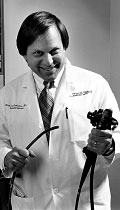DHMC pioneers two new treatments for chronic heartburn
A miniature sewing machine and a miniature microwave replace scalpels and needles in a pair of innovative surgical treatments for a common disorder. The two new devices are being used at DHMC to treat acid re- flux, the primary cause of heartburn. They offer a permanent cure for the disorder in an hourlong, outpatient procedure.
Richard Rothstein, M.D., an associate professor of medicine at DMS and chief of gastroenterology at DHMC, was the first physician in the country to use the two devices.
Acid reflux, also called gastroesophageal reflux, affects 17 million Americans. Heartburn symptoms result when the lower sphincter of the esophagus fails to block stomach acids and digestive enzymes from leaking out of the stomach, allowing these irritating substances to flow up into the throat and mouth.

|
DHMC gastroenterologist Richard Rothstein was the first physician in the country to use this device, which offers a permanent cure for heartburn in an outpatient procedure. Photo: Flying Squirrel Graphics |
Until recently, the only recourse for people with chronic heartburn was either laparoscopic surgery—repair of the defective sphincter through a small incision in the abdomen—or acid-suppressing medication. Although these treatments show success rates of 90 to 95%, the impermanence and ongoing cost of antacids and the high cost, side effects, and physical pain of surgery prompted the invention of the new devices.
Stitches: The miniature sewing machine, called Bard Endoscopic Sewing System, was developed in 1991 by a British gastroenterologist, Dr. Paul Swain. Swain attached a sewing device to the tip of an endoscope—a tube equipped with fiberoptics that can be snaked through the body's own natural openings and cavities. This allows doctors to operate on the esophagus through the mouth.
During the procedure, several stitches are placed just below the stomach's junction with the esophagus. The procedure takes about an hour, and patients can go home the same day with no restrictions on activity or diet.
In March 1998, Dartmouth became the first place in America to test endoscopic sewing on a human. Subsequently, seven other medical centers became involved in a cooperative study to assess the safety and utility of the procedure as a treatment for heartburn symptoms. The study included 64 patients, and endoscopic sewing proved to be safe and effective for over two-thirds of them.
The procedure has now received FDA approval, and demand for it has grown. "There have been 30 to 50 patients who have already called in the first week after the FDA approved it," says Rothstein.
Heat: The microwave device, called Stretta, was created by Dr. David Utley, an instructor of surgery at Stanford, and is produced by Curon Medical, Inc. The technique uses radio-frequency heat and microwave energy to tighten the lower esophageal sphincter. This thickens the muscle, scars it, and ultimately stiffens it to prevent stomach acid and digestive enzymes from flowing back into the esophagus.
With both techniques, the relief from heartburn is fairly quick, says Rothstein—usually within a month and often sooner. In fact, the sewing procedure can have an effect within several days and sometimes immediately following surgery. Patients can go home and eat anything they want, some for the first time in years. Most no longer need antacids, he adds.
Dartmouth will also be involved in teaching these procedures. Rothstein and his nurse, Cindy Darling, have already demonstrated them in France and Portugal and soon will be touring through Brazil. "We believe that training needs to happen in an organized fashion," Rothstein says, "and the original investigators are now busy training the other folks who will do the rest of the studies."
Since both devices are still being investigated, comparisons between them and predictions for the future must await further trials. However, Rothstein is hopeful that the devices will find a permanent place in the treatment of heartburn. "If there is a benefit of some durability, then I think that we will see endoscopic therapy for reflux disease fit into our armamentarium between medical therapy and surgical therapy," he says.
Rothstein, who is a consultant for the company that manufactures the sewing device but does not own any stock in either firm, explains that "I am trying to use my expertise to help [Bard] design the best product that they could design, and also think about designing the best studies that would answer some of the . . . questions about what we're doing.
"I don't necessarily see it as a conflict," he adds. "Our patients who enter the studies do become aware that this is an investigational device."
Orifices: He adds that both of these devices are consistent with the trend toward doing surgery without any incisions—the aim being to turn long, painful operations and recuperations into short, outpatient procedures. "It is an exciting time," says Rothstein. "I think more and more we will be using nature's own orifices to operate."
Sara Connolly
If you would like to offer any feedback about this article, we would welcome getting your comments at DartMed@Dartmouth.edu.
